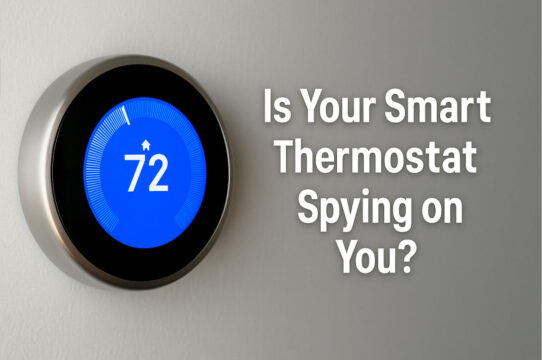Your smart thermostat is basically a nosy roommate

Charles in San Antonio asked, “Kim, I have one of those smart thermostats. It must collect a lot of my data. Where does it all go?”
Buckle up, Charles, because your thermostat might know more about you than your best friend, your doctor or your cat. If you’ve got a Nest, Ecobee or any of those sleek little screens controlling your HVAC, they’re managing temperature while they basically stalk you, politely and with your permission.
Smart thermostats have evolved. They don’t just follow schedules; they predict them. That means they’re quietly paying attention to the kind of stuff normally reserved for very nosy roommates.
🔍 What it’s tracking
- The time you leave and return home
- Which rooms you’re in the most (thanks to motion sensors)
- How long it takes to hit your ideal temp
- Your sleep and wake-up patterns
All this creepy-cool behavioral tracking gets sent to the cloud to “optimize” your comfort and help you save on energy.
If your thermostat knows your schedule, chances are someone else could, too. That data might be shared with advertisers, third-party companies, or worse, it could be accessed by cybercriminals if your account isn’t locked down.
🔧 What you can do about it
Turning off these smart features below is a great move for your privacy, but there are a few catches.
You’ll lose a bit of the magic that makes your thermostat “smart.” Without learning or motion sensing, it won’t adjust based on your routines or know when you’re home or away. You’ll need to set manual schedules.
Disabling data sharing and deleting your history means no more personalized insights or energy reports. You could also miss out on utility rebates that rely on usage tracking.
If you’re OK giving up convenience, the trade-off is keeping Big Tech out of your living room. Note: Steps below work for most, but may vary based on your specific model number.
1. Turn off auto-learning
- Nest: Google Home app > Tap your thermostat > Settings > Temperature Preferences > Auto-Schedule or Smart Schedule (4th gen) > Off.
- Ecobee: Menu (three lines) > General > Preferences > Smart Recovery > Disable.
2. Disable motion or occupancy sensors
- Nest: Settings > Presence sensing > Turn off “Allow this home to use phone locations.”
- Ecobee: Menu > General > Sensors > Tap each one > Participation > Disable “Smart Home & Away.”
3. Review your data-sharing settings
- Nest: myactivity.google.com > Activity Controls > Turn off Web & App Activity.
- Ecobee: Account > Donate Your Data > Toggle off Donate Thermostat Data > Confirm.
4. Delete your usage history
- Nest: Visit Google My Activity > Filter by date & product > Select Nest > Apply > Delete results > Delete.
- Ecobee: Fill out a Personal Information form to request data deletion.
🎅🏻 Basically, your thermostat knows when you’re sleeping, it knows when you’re awake, it knows if you’ve been bad or good, so be good for goodness’ sake.
🌡️ Let me tell you, my husband and I are playing the passive-aggressive thermostat game lately. I’m winning 73 to 68.
Tags: cybercriminals, Google, home, privacy, settings